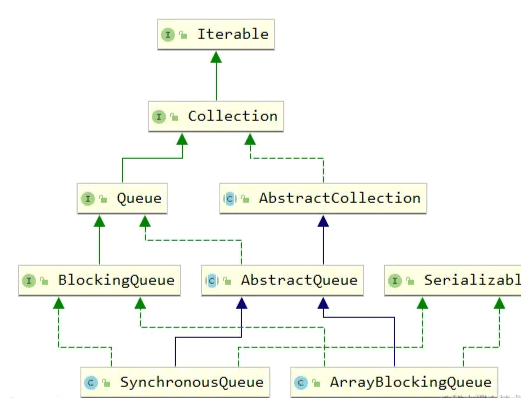Java如何自定义线程池中队列
背景
业务交互的过程中涉及到了很多关于SFTP下载的问题,因此在代码中定义了一些线程池,使用中发现了一些问题,
代码类似如下所示:
public class ExecutorTest {
private static ExecutorService es = new ThreadPoolExecutor(2,
100, 1000, TimeUnit.MILLISECONDS
, new ArrayBlockingQueue<>(10));
public static void main(String[] args) {
for (int i = 0; i < 10; i++) {
es.submit(new MyThread());
}
}
static class MyThread implements Runnable {
@Override
public void run() {
for (; ; ) {
System.out.println("Thread name=" + Thread.currentThread().getName());
try {
TimeUnit.SECONDS.sleep(2);
} catch (InterruptedException e) {
e.printStackTrace();
}
}
}
}
}
如上面的代码所示,定义了一个初始容量为2,最大容量为100,队列长度为10的线程池,期待的运行结果为:
Thread name=pool-1-thread-1
Thread name=pool-1-thread-2
Thread name=pool-1-thread-3
Thread name=pool-1-thread-4
Thread name=pool-1-thread-5
Thread name=pool-1-thread-6
Thread name=pool-1-thread-7
Thread name=pool-1-thread-8
Thread name=pool-1-thread-9
Thread name=pool-1-thread-10
Thread name=pool-1-thread-3
Thread name=pool-1-thread-5
Thread name=pool-1-thread-2
Thread name=pool-1-thread-1
Thread name=pool-1-thread-4
Thread name=pool-1-thread-10
Thread name=pool-1-thread-7
Thread name=pool-1-thread-6
Thread name=pool-1-thread-9
Thread name=pool-1-thread-8
Thread name=pool-1-thread-3
Thread name=pool-1-thread-4
Thread name=pool-1-thread-1
Thread name=pool-1-thread-5
Thread name=pool-1-thread-2
Thread name=pool-1-thread-8
Thread name=pool-1-thread-6
Thread name=pool-1-thread-7
Thread name=pool-1-thread-9
Thread name=pool-1-thread-10
期待十个线程都可以运行,但实际的执行效果如下:
Thread name=pool-1-thread-1
Thread name=pool-1-thread-2
Thread name=pool-1-thread-2
Thread name=pool-1-thread-1
Thread name=pool-1-thread-1
Thread name=pool-1-thread-2
Thread name=pool-1-thread-1
Thread name=pool-1-thread-2
Thread name=pool-1-thread-2
Thread name=pool-1-thread-1
Thread name=pool-1-thread-2
Thread name=pool-1-thread-1
Thread name=pool-1-thread-2
Thread name=pool-1-thread-1
对比可以看出,用上面的方式定义线程池,最终只有两个线程可以运行,即线程池的初始容量大小。其余线程都被阻塞到了队列ArrayBlockingQueue<>(10)
问题分析
我们知道,Executors框架提供了几种常见的线程池分别为:
- newCachedThreadPool创建一个可缓存线程池,如果线程池长度超过处理需要,可灵活回收空闲线程,若无可回收,则新建线程。
- newFixedThreadPool 创建一个定长线程池,可控制线程最大并发数,超出的线程会在队列中等待。
- newScheduledThreadPool 创建一个定长线程池,支持定时及周期性任务执行。
- newSingleThreadExecutor 创建一个单线程化的线程池,它只会用唯一的工作线程来执行任务,保证所有任务按照指定顺序(FIFO, LIFO, 优先级)执行。
如果将代码中自定义的线程池改为 :
private static ExecutorService es = Executors.newCachedThreadPool();
运行发现,提交的十个线程都可以运行
Executors.newCachedThreadPool()的源码如下:
/**
* Creates a thread pool that creates new threads as needed, but
* will reuse previously constructed threads when they are
* available. These pools will typically improve the performance
* of programs that execute many short-lived asynchronous tasks.
* Calls to {@code execute} will reuse previously constructed
* threads if available. If no existing thread is available, a new
* thread will be created and added to the pool. Threads that have
* not been used for sixty seconds are terminated and removed from
* the cache. Thus, a pool that remains idle for long enough will
* not consume any resources. Note that pools with similar
* properties but different details (for example, timeout parameters)
* may be created using {@link ThreadPoolExecutor} constructors.
*
* @return the newly created thread pool
*/
public static ExecutorService newCachedThreadPool() {
return new ThreadPoolExecutor(0, Integer.MAX_VALUE,
60L, TimeUnit.SECONDS,
new SynchronousQueue<Runnable>());
}
通过对比发现,newCachedThreadPool使用的是 SynchronousQueue<>()而我们使用的是ArrayBlockingQueue<>(10) 因此可以很容易的发现问题出在队列上。
问题解决
将ArrayBlockingQueue改为SynchronousQueue 问题解决,代码如下:
public class ExecutorTest {
private static ExecutorService es = new ThreadPoolExecutor(2,
100, 1000, TimeUnit.MILLISECONDS
, new SynchronousQueue<>());
private static ExecutorService es2 = Executors.newCachedThreadPool();
public static void main(String[] args) {
for (int i = 0; i < 10; i++) {
es.submit(new MyThread());
}
}
static class MyThread implements Runnable {
@Override
public void run() {
for (; ; ) {
System.out.println("Thread name=" + Thread.currentThread().getName());
try {
TimeUnit.SECONDS.sleep(2);
} catch (InterruptedException e) {
e.printStackTrace();
}
}
}
}
}
总结
两个队列的UML关系图

从图上我们可以看到,两个队列都继承了AbstractQueue实现了BlockingQueue接口,因此功能应该相似
SynchronousQueue的定义
* <p>Synchronous queues are similar to rendezvous channels used in * CSP and Ada. They are well suited for handoff designs, in which an * object running in one thread must sync up with an object running * in another thread in order to hand it some information, event, or * task.
SynchronousQueue类似于一个传递通道,只是通过他传递某个元素,并没有任何容量,只有当第一个元素被取走,才能在给队列添加元素。
ArrayBlockingQueue的定义
* A bounded {@linkplain BlockingQueue blocking queue} backed by an
* array. This queue orders elements FIFO (first-in-first-out). The
* <em>head</em> of the queue is that element that has been on the
* queue the longest time. The <em>tail</em> of the queue is that
* element that has been on the queue the shortest time. New elements
* are inserted at the tail of the queue, and the queue retrieval
* operations obtain elements at the head of the queue.
ArrayBlockingQueue从定义来看就是一个普通的队列,先入先出,当队列为空时,获取数据的线程会被阻塞,当队列满时,添加队列的线程会被阻塞,直到队列可用。
分析
从上面队列的定义中可以看出,导致线程池没有按照预期运行的原因不是因为队列的问题,应该是关于线程池在提交任务时,从队列取数据的方式不同导致的。
jdk源码中关于线程池队列的说明
* <dt>Queuing</dt>
*
* <dd>Any {@link BlockingQueue} may be used to transfer and hold
* submitted tasks. The use of this queue interacts with pool sizing:
*
* <ul>
*
* <li> If fewer than corePoolSize threads are running, the Executor
* always prefers adding a new thread
* rather than queuing.</li>
*
* <li> If corePoolSize or more threads are running, the Executor
* always prefers queuing a request rather than adding a new
* thread.</li>
*
* <li> If a request cannot be queued, a new thread is created unless
* this would exceed maximumPoolSize, in which case, the task will be
* rejected.</li>
从说明中可以看到,如果正在运行的线程数必初始容量corePoolSize小,那么Executor会从创建一个新线程去执行任务,如果正在执行的线程数必corePoolSize大,那么Executor会将新提交的任务放到阻塞队列,除非当队列的个数超过了队列的最大长度maxmiumPooSize。
从源码中找到关于提交任务的方法:
public Future<?> submit(Runnable task) {
if (task == null) throw new NullPointerException();
RunnableFuture<Void> ftask = newTaskFor(task, null);
execute(ftask);
return ftask;
}
从源码中看到 subimit实际上是调用了execute方法
execute方法的源码:
public void execute(Runnable command) {
if (command == null)
throw new NullPointerException();
/*
* Proceed in 3 steps:
*
* 1. If fewer than corePoolSize threads are running, try to
* start a new thread with the given command as its first
* task. The call to addWorker atomically checks runState and
* workerCount, and so prevents false alarms that would add
* threads when it shouldn't, by returning false.
*
* 2. If a task can be successfully queued, then we still need
* to double-check whether we should have added a thread
* (because existing ones died since last checking) or that
* the pool shut down since entry into this method. So we
* recheck state and if necessary roll back the enqueuing if
* stopped, or start a new thread if there are none.
*
* 3. If we cannot queue task, then we try to add a new
* thread. If it fails, we know we are shut down or saturated
* and so reject the task.
*/
int c = ctl.get();
if (workerCountOf(c) < corePoolSize) {
if (addWorker(command, true))
return;
c = ctl.get();
}
if (isRunning(c) && workQueue.offer(command)) {
int recheck = ctl.get();
if (! isRunning(recheck) && remove(command))
reject(command);
else if (workerCountOf(recheck) == 0)
addWorker(null, false);
}
else if (!addWorker(command, false))
reject(command);
}
源码中可以看出,提交任务时,首先会判断正在执行的线程数是否小于corePoolSize,如果条件成立那么会直接创建线程并执行任务。如果条件不成立,且队列没有满,那么将任务放到队列,如果条件不成立但是队列满了,那么同样也新创建线程并执行任务。
到此这篇关于Java如何自定义线程池中队列的文章就介绍到这了,更多相关Java 队列内容请搜索猪先飞以前的文章或继续浏览下面的相关文章希望大家以后多多支持猪先飞!
原文出处:https://juejin.cn/post/7111347895151886367
相关文章
- 这篇文章主要介绍了如何利用java语言实现经典《复杂迷宫》游戏,文中采用了swing技术进行了界面化处理,感兴趣的小伙伴可以动手试一试...2022-02-01
基于springcloud异步线程池、高并发请求feign的解决方案
这篇文章主要介绍了基于springcloud异步线程池、高并发请求feign的解决方案,具有很好的参考价值,希望对大家有所帮助。一起跟随小编过来看看吧...2021-02-25java 运行报错has been compiled by a more recent version of the Java Runtime
java 运行报错has been compiled by a more recent version of the Java Runtime (class file version 54.0)...2021-04-01- 这篇文章主要介绍了在java中获取List集合中最大的日期时间操作,具有很好的参考价值,希望对大家有所帮助。一起跟随小编过来看看吧...2020-08-15
- 这篇文章主要介绍了教你怎么用Java获取国家法定节假日,文中有非常详细的代码示例,对正在学习java的小伙伴们有非常好的帮助,需要的朋友可以参考下...2021-04-23
- 这篇文章主要介绍了Java如何发起http请求的实现,文中通过示例代码介绍的非常详细,对大家的学习或者工作具有一定的参考学习价值,需要的朋友们下面随着小编来一起学习学习吧...2021-03-31
- 这篇文章主要给大家介绍了关于C#创建自定义控件及添加自定义属性和事件使用的相关资料,文中通过示例代码介绍的非常详细,对大家学习或者使用C#具有一定的参考学习价值,需要的朋友们下面来一起学习学习吧...2020-06-25
- 说起C#和Java这两门语言(语法,数据类型 等),个人以为,大概有90%以上的相似,甚至可以认为几乎一样。但是在工作中,我也发现了一些细微的差别...2020-06-25
- 本文实例讲述了JS实现自定义简单网页软键盘效果。分享给大家供大家参考,具体如下:这是一款自定义的简单点的网页软键盘,没有使用任何控件,仅是为了练习JavaScript编写水平,安全性方面没有过多考虑,有顾虑的可以不用,目的是学...2015-11-08
- 这篇文章主要介绍了解决Java处理HTTP请求超时的问题,具有很好的参考价值,希望对大家有所帮助。一起跟随小编过来看看吧...2021-03-29
- 为了增强android应用的用户体验,我们可以在一些Button按钮上自定义动态的设置一些样式,比如交互时改变字体、颜色、背景图等。 今天来看一个通过重写Button来动态实...2016-09-20
- 这篇文章主要介绍了java 判断两个时间段是否重叠的案例,具有很好的参考价值,希望对大家有所帮助。一起跟随小编过来看看吧...2020-08-15
- 队列的特性很简答,就是先进先出,一般利用数组来实现,本文就介绍了C#队列的简单使用,文中根据实例编码详细介绍的十分详尽,具有一定的参考价值,感兴趣的小伙伴们可以参考一下...2022-03-17
- 这篇文章主要介绍了超简洁java实现双色球若干注随机号码生成(实例代码),本文通过实例代码给大家介绍的非常详细,对大家的学习或工作具有一定的参考借鉴价值,需要的朋友可以参考下...2021-04-02
- 这篇文章主要介绍了SpringBoot集成Redis实现消息队列的方法,文中通过示例代码介绍的非常详细,对大家的学习或者工作具有一定的参考学习价值,需要的朋友们下面随着小编来一起学习学习吧...2021-02-10
- 这篇文章主要介绍了Java生成随机姓名、性别和年龄的实现示例,文中通过示例代码介绍的非常详细,对大家的学习或者工作具有一定的参考学习价值,需要的朋友们下面随着小编来一起学习学习吧...2020-10-01
java 画pdf用itext调整表格宽度、自定义各个列宽的方法
这篇文章主要介绍了java 画pdf用itext调整表格宽度、自定义各个列宽的方法,具有很好的参考价值,希望对大家有所帮助。一起跟随小编过来看看吧...2021-01-31- 下面我们来看一篇关于Android自定义WebView网络视频播放控件开发例子,这个文章写得非常的不错下面给各位共享一下吧。 因为业务需要,以下代码均以Youtube网站在线视...2016-10-02
- 自定义一个jquery模态窗口插件,将它集成到现有平台框架中时,它只能在mainFrame窗口中显示,无法在顶层窗口显示. 解决这个问题的办法: 通过以下代码就可能实现在顶层窗口弹窗 复制代码 代码如下: $(window.top.documen...2014-05-31
- 这篇文章主要介绍了自定义feignClient的常见坑及解决方案,具有很好的参考价值,希望对大家有所帮助。如有错误或未考虑完全的地方,望不吝赐教...2021-10-20
